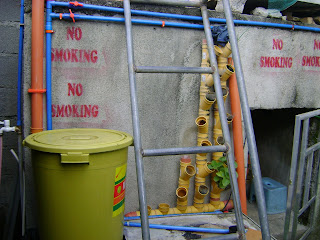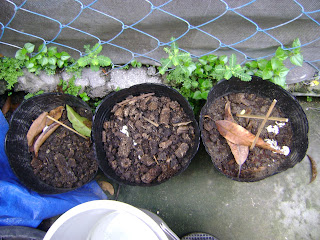Saturday, August 19, 2017
Tuesday, August 15, 2017
Aquaponics in Manual Mode
Aquaponics doesn't have to be restricted in a close loop, where setup for starters tend to be expensive. You can do aquaponics without expensive water pumps, all you need is a bucket and a deeper or watering can for that matter.
Plant your seedlings in a recycled containers or pots, then everytime you change water or clean your fish tank, use the nutrient filled water from your aquariums to water your plants. You can setup this plant filled container to filter the water or just simply on the ground.
This method is laborious, but it will save you some extra cash if you are in a tight start and earn a few muscles at the end of the day.
Weather automatic or manual, the goal is to use your fish to feed your plants and your plants to use the water or clean it.
Friday, August 11, 2017
New Weapons
"Don't Be A Fool Use The Right Tool!"
These are the words that I use to remember when working on things that requires engineering and scientific application. Words thought to me and my classmates during college days by our civil 101 instructor. Words that still ring a bell everytime I make stupid output because of stupid practice.
So this time I would like to upgrade my arsenal with new addition of tools. The TDS (Total Dissolved Solids) Meter and the PH Meter.
With the following tools I would be able to record data that are essential in troubleshooting water problems, thought these tools are still lacking, it will still be able to provide important information regarding the quality of my water with respect PH.
Tuesday, August 8, 2017
Water Filter
It is essential to maintain your water quality for your fish and plants with your aquaponics setup. Putting up your own filter is part of that challenge. In this setup I reused a margarine container filled with river rocks and pebbles, this may not be a typical filter setup found in most aquaponics but at least it will do the job and purpose intended.
I placed a standpipe in the middle as a secondary filter and as an overflow drain in case the pebbles fail when I am gone for a long time. By the way the bottom of the container is holed just enough to strain the pebbles to let water pass leaving solids behind.
Using second hand materials or reusing or up-cycling parts can save you money while helping the environment. Not only it does the job it is fun to work with.
Saturday, August 5, 2017
How to make your own clay Pebbles
Hydrotons or clay pebbles are so expensive and hard to find in my location, and if I do look for it online it will make the expenses of my aquaponics and hydroponics projects go steep!
So today I want to share to my fellow enthusiasts and visionaries of this field while making a run for their first base. The amazing DIY clay pebbles aka hydroton, but this time we will call it the clay chips ^^.
Now go get this clay pot lying around your laboratory that has not been used for a year since you've been messing around with your soilless gardening and farming. The best thing on this part, is that you can use even cracked clay pots as your raw material. For FREE I repeat FREE ^_^
So today I want to share to my fellow enthusiasts and visionaries of this field while making a run for their first base. The amazing DIY clay pebbles aka hydroton, but this time we will call it the clay chips ^^.
Now go get this clay pot lying around your laboratory that has not been used for a year since you've been messing around with your soilless gardening and farming. The best thing on this part, is that you can use even cracked clay pots as your raw material. For FREE I repeat FREE ^_^
Then go get a hammer straight from your toolbox and pound it with medium effort, the goal is to make chips of your favored sizes not to crash them to powder. And after a few minutes you will have something that would look like this.
Now you have a clay chips medium that works just like an expensive hydroton or clay pebbles! Easy and awesomely cheap! This method is tried and tested by yours truly me.
Now go out there and hunt for free clay pots around your backyard or your neighbors' I'm sure they they'll be happy to give you there unused or discarded clay pots for free. If they ask you why, just tell them climate change needs help and by recycling there pots you are doing your part with their help ^_^!
Friday, August 4, 2017
Going Hi-Tech
Making use of electronics to further develop my backyard aquaponics and urban gardening or farming. Just like the good old days of student life, making projects to ace a major subject. But this time its for the real life episode.
I stumbled upon this micro-controller called arduino a year ago, since then I was saving as much as I could to purchase parts and modules, so if a Billionaire is reading this post please hit donate, I would be more than happy to say thank you, and that your donation will go to the development of a food production facility for my local community.
These Arduinos were not cheap when they first release, Price was steep during the early days of release of this democratized MCU. But just recently prices were going down and I was able to purchase modules online. An arduino mega 2560 (1 year old), a 2 channel relay module and a DS1307 RTC with built in expansion for temperature sensor (optional).
I stumbled upon this micro-controller called arduino a year ago, since then I was saving as much as I could to purchase parts and modules, so if a Billionaire is reading this post please hit donate, I would be more than happy to say thank you, and that your donation will go to the development of a food production facility for my local community.
These Arduinos were not cheap when they first release, Price was steep during the early days of release of this democratized MCU. But just recently prices were going down and I was able to purchase modules online. An arduino mega 2560 (1 year old), a 2 channel relay module and a DS1307 RTC with built in expansion for temperature sensor (optional).
I'll be posting more updates and DIYs regarding my R&D. Post comments or questions or suggestion. Thank you for your interest and support.
"Buy Your Own Tools! Upgrade Your Skills!"
Wednesday, August 2, 2017
Urban gardening or Farming?
Gingers in pots.
Though the following setups are in pots, they are well fed with water from my fish tanks to supply the necessary nutrition that these dudes need.
Fig. 1
I have been experimenting on potting mix for my urban farming, combinations on different types of soils and organic matter from available sources, that are as much as possible for free. Figure one was a result of unused fresh water sand topped with dead and decaying leaves.
Figure 2 was a result of sand that came from the sea literally, though topped with organic matters the salt from the sand took its toll! I suspected that this would happen, but I ran out of fresh water sand and by request someone brought me the other sand ^_^
Fig. 2
Fig.3.a
Fig. 3.b
Fig 3.c
Figure 3.a to Figure 3.c are results of mixtures of fresh water sand, garden soil and organic matters. These dudes are about a month old and we will have to wait a little more to see better or worst results. But I am hoping for the best!
Subscribe to:
Posts (Atom)



















